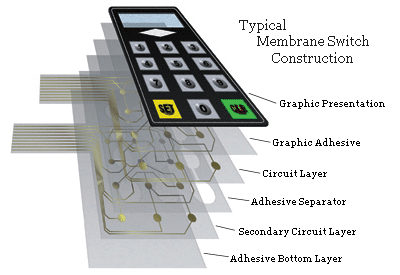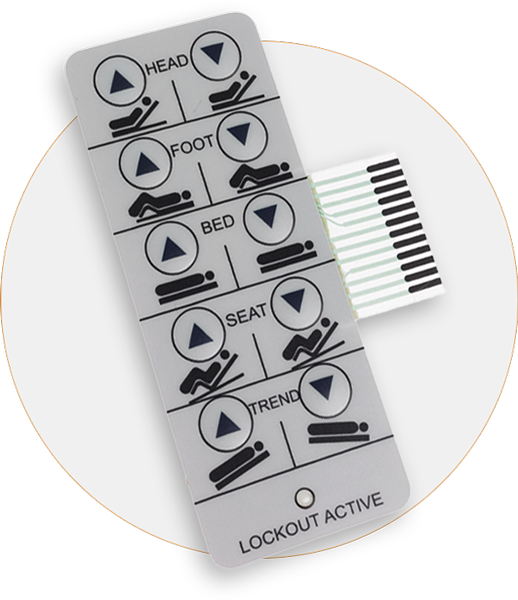All Concerning Membrane Switch: Recognizing Its Style and Functionality
When you assume regarding the control user interfaces in contemporary devices, membrane layer switches usually come to mind. Let's discover what collections membrane switches apart from other control systems.
What Are Membrane Switches?

Membrane buttons can also be customized concerning shape, dimension, and graphics, enabling producers to create distinct interfaces customized to details items. In general, membrane layer switches play a significant role in enhancing user experience throughout a large range of applications.
How Membrane Layer Switches Job
When you press a trick on a membrane button, it activates a straightforward yet reliable system. The leading layer, often made of adaptable material, lowers onto a conductive layer under it. This activity bridges the space in between conductive traces, completing an electric circuit. As quickly as the circuit shuts, it sends out a signal to the device's controller, which interprets your input.
You'll notice that the tactile feedback differs based on the switch style, providing either a soft click or a much more noticable feedback. Once you launch the key, the membrane go back to its initial position, resuming the circuit and stopping the signal. This procedure happens practically instantaneously, guaranteeing a responsive user experience.
Membrane layer buttons are popular as a result of their toughness and resistance to dust and moisture, making them perfect for different applications, from house home appliances to clinical devices. Understanding this procedure helps you appreciate their widespread use.
Key Parts of Membrane Buttons
Comprehending the crucial parts of membrane switches is basic for grasping their functionality and design. At the core, you'll discover the visuals overlay, which offers the aesthetic user interface for individuals. Below that, there's a spacer layer that separates the circuit layers, making certain that they do not make call until pressed. The circuit layer is where the magic occurs; it contains conductive traces that finish the circuit when you push the button. An additional necessary element is the adhesive backing, enabling the switch to comply with surface areas firmly. Lastly, the protective layer shields against environmental aspects and put on, expanding the switch's lifespan. Each component plays a significant duty in guaranteeing trustworthy performance and user communication. By understanding these elements, you'll gain understanding right into exactly how membrane switches run and their importance in different applications.
Products Used in Membrane Switch Style
The efficiency and toughness of membrane changes greatly depend upon the materials made use of in their layout. You usually experience polyester and polycarbonate as main substrates because of their excellent toughness and versatility. These products withstand scrapes and chemicals, making them perfect for requiring settings.
The conductive layers typically make use of silver or carbon, chosen for their reliability and conductivity. membrane switch manufacturer. Silver offers remarkable efficiency, while carbon is an affordable alternative. For the overlay, you could take into consideration a matte or glossy finish, depending on your visual needs and user experience
Make particular to pick adhesives that endure ecological factors like temperature level and moisture. Picking the appropriate products will certainly assure your membrane switch stands the examination of time.
Style Factors To Consider for Membrane Layer Switches
While designing membrane layer switches, it's crucial to take right into account various variables that influence their functionality and user experience. Start by concentrating on the design and switch dimension; make sure they're intuitive and simple to navigate. Think about the responsive comments you desire to provide-- will users require a noticeable click or a softer touch? In addition, think of the products you'll utilize, as they'll impact longevity and looks.
Do not forget the graphic design; clear labeling and color comparison are significant for presence. Verify your layout suits ecological factors, like wetness or temperature variations, which could influence performance. Keep in mind the value of screening the original source models with actual individuals to collect comments and make necessary adjustments. This iterative process helps you improve the layout, validating it meets both useful and visual requirements effectively. By meticulously thinking about these components, you'll produce a membrane switch that boosts functionality and fulfillment.
Applications of Membrane Buttons
Membrane layer buttons are functional parts found in numerous applications, from commercial equipment to consumer electronics. You'll see their effect in devices that call for durable user interfaces and in devices that gain from sleek styles. Comprehending these applications helps you value the functionality and usefulness of membrane buttons in everyday technology.
Industrial Tools Usage
When you're aiming to improve the functionality of industrial equipment, membrane layer buttons supply a trustworthy solution that incorporates longevity with user-friendly style. These switches are ideal for extreme atmospheres, offering resistance to dirt, moisture, and chemicals. You'll discover them in control panels for making devices, heating and cooling systems, and clinical tools, where accuracy and responsiveness are crucial. Their reduced account indicates they fit effortlessly into different tools, saving important space while keeping convenience of use. With personalized graphics and backlighting options, you can develop an user-friendly interface for drivers, improving efficiency and safety. And also, their long lifespan minimizes upkeep prices, making them a wise investment for your commercial applications. Accept membrane switches to simplify your procedures and boost overall performance.
Customer Electronics Integration
In the domain of consumer electronic devices, membrane layer switches play an essential role in improving individual interaction and device functionality. You'll locate them in tools like microwaves, remote controls, and pc gaming consoles, giving a smooth means to connect with modern technology. Their smooth layout allows for easy integration right into click over here numerous products, making controls instinctive and straightforward. With their capacity to include graphics and backlighting, you can appreciate a contemporary aesthetic that complements the tool's general appearance. Membrane layer switches likewise guarantee sturdiness and resistance to dust and dampness, prolonging the lifespan of your electronic devices. By picking membrane buttons, you improve not just the capability but also the style of your devices, making day-to-day interactions smooth and delightful.
Advantages and Drawbacks of Membrane Layer Switches
While membrane layer buttons provide an array of benefits, they also include some disadvantages that you must take into consideration. One considerable benefit is their compact style, making them perfect for space-constrained applications. They're likewise cost-efficient, offering a sturdy service with a low manufacturing price. Additionally, their smooth surface area is very easy to clean, improving health in settings like healthcare facilities.

Membrane buttons can have a much shorter life-span contrasted to mechanical switches, particularly under hefty use. They can also be much less tactile, which might affect customer comments during procedure. Stabilizing these pros and disadvantages will aid you check determine if membrane layer switches are the right fit for your job.
Regularly Asked Concerns
How Much Time Do Membrane Switches Commonly Last?
Membrane switches over normally last between 5 to ten years, depending on usage and ecological conditions. You'll intend to evaluate elements like wear, exposure to moisture, and temperature level fluctuations to assess their long life efficiently.
Can Membrane Layer Switches Be Personalized for Certain Designs?
Yes, you can personalize membrane switches to fit certain layouts (membrane switch manufacturer). You'll have the freedom to choose shades, shapes, and designs that match your task's requirements, guaranteeing they mix perfectly with your overall aesthetic
What Is the Price Range for Membrane Switch Over Manufacturing?
The expense array for membrane layer switch production normally drops between $1 and $10 per device, depending on elements like layout complexity, amount, and materials. You can get quotes from manufacturers to locate the ideal alternative.

Are Membrane Layer Switches Water-proof or Immune?
Membrane layer switches can be made to be water resistant or immune, depending upon materials utilized and building and construction techniques. If you require them for damp atmospheres, guarantee you define those needs throughout the layout procedure.
How Do Membrane Layer Switches Contrast to Conventional Buttons?
Membrane layer buttons are generally thinner and a lot more flexible than standard switches, using a smooth style. They're usually simpler to clean up and integrate, however could not give the responsive responses you're used to with mechanical options.
Final thought

Comments on “You’ll experience the difference when collaborating with a high-quality membrane switch manufacturer.”